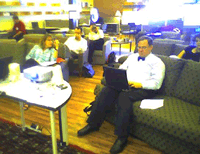 I spent two days, last week, sitting with a group of educators in a renovated tobacco warehouse in Durham, North Carolina. The residence of Duke CE, a corporate education firm, the now upscaled facility became a short-term incubator of ideas — about teaching and learning.
I spent two days, last week, sitting with a group of educators in a renovated tobacco warehouse in Durham, North Carolina. The residence of Duke CE, a corporate education firm, the now upscaled facility became a short-term incubator of ideas — about teaching and learning.
The event was both enlightening and energizing to me. In my work, I typically associate my ideas with those of other K-12 educators. Here, I was the sole K-12 person, surounded by corporate and higher-ed people. I learned loads listening to the perspectives of others who educate, and filtering my own ideas through their lenses.
I want to mention one of the participants. George Siemens, an instructor at Red River College in Winnipeg, brought some insights to the group that were especially useful to me. George Siemens is one of those names that I have increasingly heard mentioned over the months in discussion about Web 2.0 and its application in education. He describes a theory of learning that he calls Connectivism. You can learn more about it from a piece called Connectivism: A Learning Theory for the Digital Age, which was originally published in December, 2004, and updated this April.
I’m sure that George’s aggregator will capture this, so I hope that he corrects any misconceptions that I may have. The problem he is attacking is the “half-life of knowledge”, the time that it takes for knowledge to become obsolete. As knowledge half-life rapidly shrinks, what does it mean to our efforts, as educators, to help students learn more. How does this change the nature of education and the label of being educated?
I was especially excited by George’s contributions to the roundtable, because he provided for me some much needed vocabulary for things that have been rolling around in my head for some time. One of the foundations of connectivism is that the “Capacity to know more is more critical than what is currently known.” He states that (and I’ll certainly be parroting this one) “knowing what” and “knowing how” are not as important as “knowing where” to find the information.
I could go on, but the bottom line, as I see it, is that part of teaching today should be helping students to create and cultivate a network of people and resources that can follow us around, helping us to find the information that we need to do what we need to do, right now. I often talk about helping students to cultivate a personal digital library. The metaphor I see here is that we need a person digital university, with library, student union, faculty offices, academic and special interest clubs, and most other aspects of the university environment — but digital, virtual, and constantly adapting to needs and opportunities.
I guess that in a real sense, my aggregator is a big part of my linkage to my learning network. It includes links to people, their ideas, and their resources, not to mention pictures.

Hi Dave – It was great to have you at the Learning Technology Roundtable. One of the fascinating puzzles for us at Duke CE is related to how young adults are growing up in a world of connected resources (people and information) and how we anticipate and build for this in our program designs. Your experience in the K-12 sector was very much appreciated as it helped us step out of our box and consider the near and longer-term future.
Thanks again for coming and spending time with us!
Steve